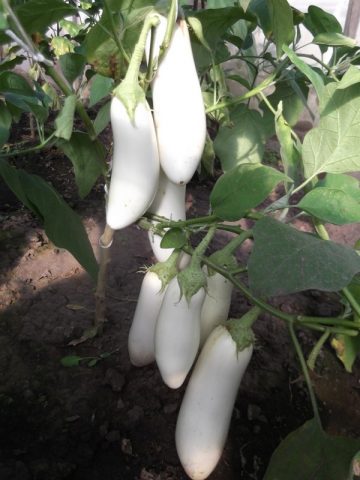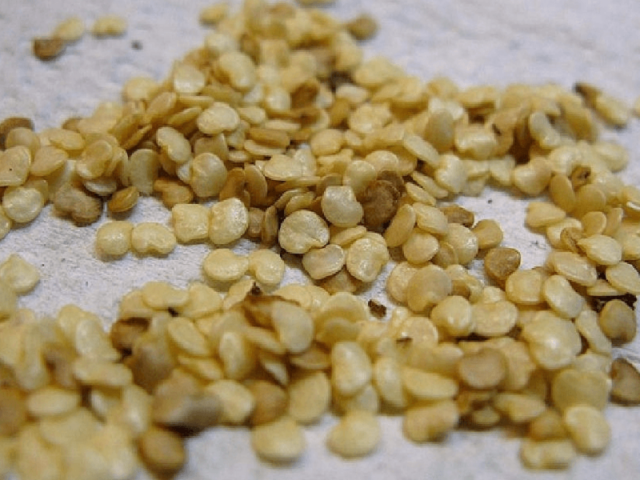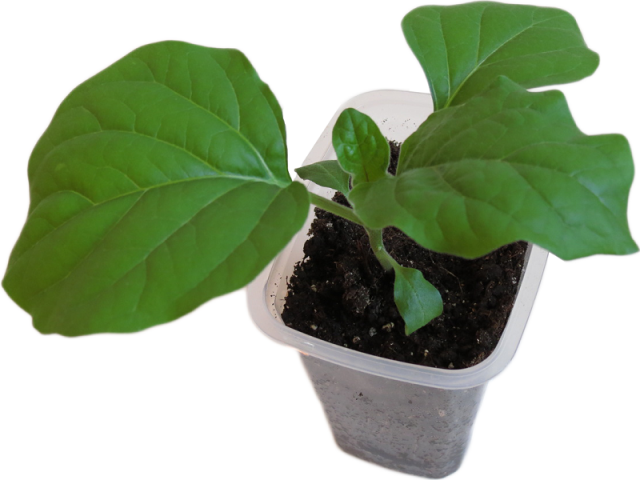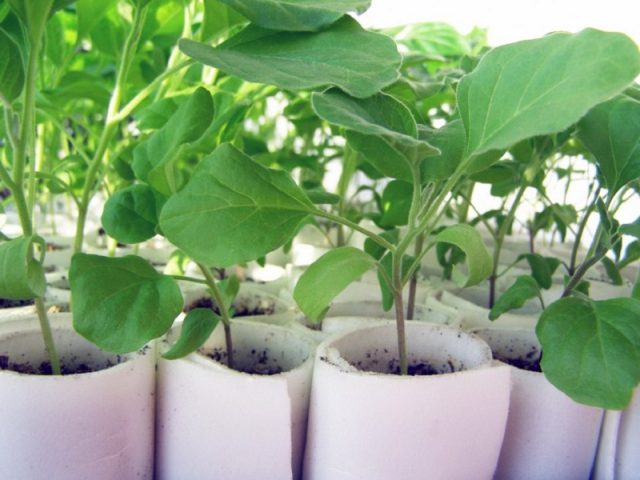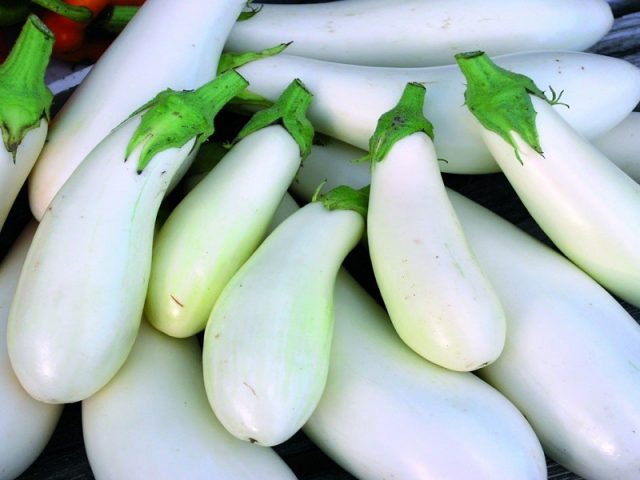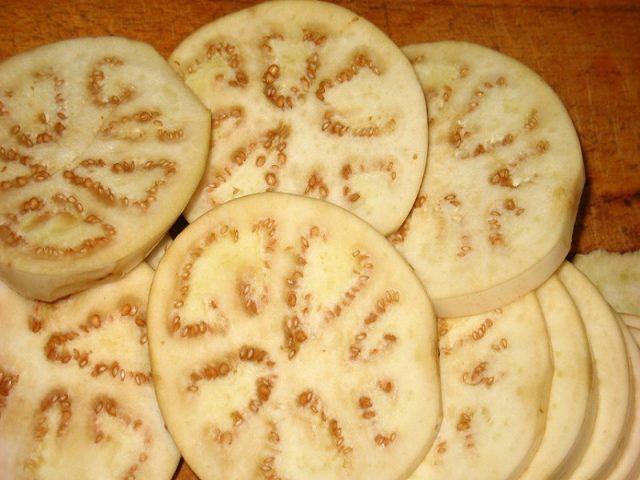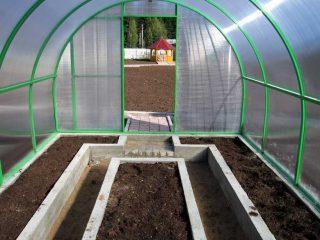Content
As a result of the work of breeders, many new interesting varieties of vegetable crops appear, surprising with their appearance and taste. One of them is Snowy Eggplant, which has a pure white skin. This is surprising, since the vegetable is usually called "blue" - for the characteristic color of the fruit. The new variety completely refutes this popular definition, while retaining all the characteristics of the eggplant so beloved by gardeners and gardeners.
Description of eggplant Snowy
The Snezhny eggplant variety was bred as a hybrid of purple eggplant at the All-Russian Research Institute of Selection and Seed Production of Vegetable Crops. In 2000, it was entered into the State Register for the Russian Federation. Recommended for growing in film shelters in garden plots, in farms.
Eggplant of the Snezhny variety is an annual herb of a semi-spreading type, the height of which reaches 1 m, belongs to indeterminate (having unlimited growth). The stem initially has a herbaceous structure, and becomes woody at the age of two months. The leaves are alternate, medium, rough and slightly prickly, with small notches at the edges, the plates are thick and soft. The foliage is light green. The root system develops poorly at first, later it begins to grow rapidly and reaches a depth of up to 0.5 m. Its main part is located no deeper than 30 cm. The roots are extremely sensitive to dry soil and a lack of nutrients in it.
The flowers of the Snezhny eggplant variety are of both sexes, white, large, 3 cm in diameter, located in inflorescences. Their anthers are yellow, two-chambered, are on the same level with the stigma of the pistil, so self-pollination is almost always complete. The calyx has no thorns. The Snezhny eggplant variety belongs to the early maturing. The fruits ripen 106 days after sowing. The seeds are small, flat, creamy. Ripen in August.
Growing in most of the Russian Federation is possible only under a film cover, in the southern regions - in open ground.
Description of fruits
White eggplant was developed by scientists to improve the palatability of common varieties that contain anthocyanins. It is thanks to him that the fruits of the plant have the usual purple color, and the bitter taste is due to the presence of corned beef. As a result of selection work, white eggplants of the Snezhny variety are deprived of these two substances. It became possible to use them fresh.
Ripe fruits have an elongated (up to 25 cm) curved cylindrical shape. The mass of one fruit is about 300 g. The skin is smooth, glossy, snow-white, very thin. The eggplant pulp Snow is dense, with a creamy hue. There is no bitterness.
Variety characteristics
According to the photo and description of Snezhny eggplant, you can evaluate the characteristics of the variety, which has its own characteristics and properties:
- ripening dates - early;
- purpose - universal;
- yield - high;
- marketable and taste qualities are excellent;
- growing place - open and closed ground.
Productivity, fruiting
Sowing of Snowy eggplants is carried out in late February - early March. In the two-leaf phase, the plants dive. In mid-May, the seedlings are planted in the greenhouse. The Snezhny variety begins to bear fruit in 100 - 105 days after germination. The mass of one fruit of technical ripeness reaches 300 g. The eggplant yield is about 5 kg / sq. m.
The Snezhny variety is very picky about conditions and care. Several factors affect yield:
- temperature;
- lighting;
- transplant quality;
- planting density;
- soil composition.
With sharp fluctuations in temperature, the ovaries may fall off. With a prolonged decrease in it, the plants die, and the seeds do not germinate. The optimum air temperature for growing conditions is -25 ⁰С.
Seedlings are harmful both to strong sunlight, which can cause leaf burns, and prolonged cloudy weather.
Snezhny eggplant does not tolerate picking and replanting poorly. If the root system is damaged, its survival rate decreases.
Thickening during planting is unacceptable, since this will negatively affect the yield and size of the fruits.
The cultivation of Snowy eggplant is most successful on light, well-fertilized soils.
Application area
Snezhny eggplant has a mild taste without bitterness. When cooked properly, the vegetable takes on a mushroom or chicken flavor. It can be fried, stewed, grilled, marinated, caviar and salads cooked, eaten raw.
When frozen, white eggplants do not lose their beneficial properties. After defrosting, you can cook casseroles, rolls, snacks from them. The vegetable contains a lot of fiber, which has a beneficial effect on the functioning of the gastrointestinal tract.
Powder and juice from fruits are used in medicine, since their use makes it possible to reduce the level of "bad" cholesterol. They help with gout, atherosclerosis, liver and kidney diseases.
Disease and pest resistance
Snowy eggplant is a hybrid, therefore it is more resistant to diseases than the main varieties. But fungal and viral diseases affect the fruits and leaves of the plant. Among them:
- mosaic;
- stolbur;
- gray rot;
- bacterial spotting;
- blackleg;
- late blight;
- white rot;
- fusarium;
- cercosporosis;
- anthracnose.
To combat blackleg, soil disinfection with bleach solution and ash treatment are used. Using a solution of hydrochloric acid, you can process inventory and eggplant seeds from a mosaic. The pillar is carried by cicadas, so the fight against the disease consists in the destruction of insects.
You can grow healthy plants following agricultural techniques:
- processing seeds before sowing;
- isolating plants that can attract pests;
- disinfecting or replacing the soil before planting seedlings;
- controlling the microclimate in the greenhouse;
- regularly examining the plants;
- timely and thoroughly deleting weeds;
- periodically making top dressing;
- observing the mode of airing the greenhouse and watering the plants.
Among the parasites that infect the Snezhny eggplant variety:
- aphid;
- slugs;
- spider mite;
- bear;
- Colorado beetle;
- whitefly.
Methods for dealing with them are reduced to the use of traps, manual collection and the use of insecticides. Gardeners and gardeners, leaving reviews with a photo about Snezhny eggplant, note the effectiveness of folk methods in the fight against pests and diseases.
Advantages and disadvantages of the variety
Despite the fact that white eggplants of the Snezhny variety were bred on the basis of purple ones, they have their pros and cons. Among the advantages:
- pleasant taste without bitterness;
- delicate structure;
- thin skin;
- little or no seeds;
- versatility of application;
- low calorie content of the product;
- benefits for the body due to the large amount of fiber in the fruit;
- high content of micro and macro elements.
The disadvantages of the Snezhny variety include:
- short shelf life of vegetables;
- transportation difficulties;
- the need for soil with high quality indicators for growing crops;
- poor plant resistance to temperature extremes;
- inability to collect seed;
- poor tolerance to high temperatures (more than 25 ⁰С).
Features of planting and care
To get the eggplant harvest as early as possible, use the seedling method. Sowing seeds is carried out in late February and early March.After 50 days, the seedlings are planted indoors.
The cultivation takes place according to the plan:
- Sorting - Submerge seeds in saline solution (1.3%) for 5 minutes. Rinse and dry the grains that have settled to the bottom.
- Disinfection - place the seeds in a 1% solution of potassium permanganate for 20 minutes.
- Hardening - place in the fruit compartment of the refrigerator for 48 hours a week before sowing.
- Soaking - dip in the growth stimulant solution according to the instructions.
- Prepare a soil mixture - peat, humus and sand.
- Sowing - plant three seeds in separate glasses to a depth of 1 cm.
- Place the container in a warm place (25 ⁰С).
- Watering - periodically, with warm water, using a spray bottle.
- Backlight - Provide additional lighting for 12 hours.
- Top dressing - every two weeks.
Planting technology of the Snezhny variety:
- Make beds 1 meter wide.
- Mark the holes in two rows according to the 60 x 40 cm pattern.
- Spill the wells with warm water.
- Plant the plants, deepening the neck 2 cm.
- Drizzle.
In the future, caring for an eggplant of the Snezhny variety, you must perform the following steps:
- Mulch the soil under the plants with hay, straw, needles or other materials.
- Organize regular watering of the plants.
- Feed them twice a month.
- Remove some of the ovaries to obtain larger fruits.
Conclusion
Snowy eggplant is a healthy vegetable with an interesting mild taste without bitterness. It is suitable for use both raw and after heat treatment. Growing requires painstaking work, but caring for Snow White eggplant is no more difficult than for purple varieties. Wonderful appearance, excellent taste, yield of the Snezhny variety are good reasons for growing a crop on your site.
